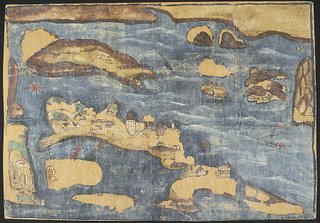"Folha 72
Quatro legoas de Manorá pelo sertão está a serra de Aserim como se vê; tem ao pé huma tranqueira com seu capp.ao e 120 homens de prezidio; chamase este prezidio povoação Vamapor; comessando a subir pella serra athé hum passo q será meya legoa se pode hir em palanquim; chamase a este passo Salada, de onde está hum naiq com sinco ou seis soldados; daqui pª sima se vay a pé até outro passo q chamão Boa Esperança; e dahi à porta donde se vay por dentro da terra por huma escada lavrada ao picão, donde está o alçapão, no qual sítio vivem quatro ou sinco moradores; ali está a porta da fortaleza com muy grossos forrolhos, feita em hum muro com sua artelharia; aqui mora o porteiro da fortaleza donde não entra ninguém nem sahe sem licença do Capp.ao. No cume desta serra está a povoação q constará de 150 vezinhos pª tomar armas. A altura desta serra he huma legoa; o cercuito da povoação he quasi circulo perfeito; e terá mil palmos de diâmetro; Vezinha com os mesmos de Manorá; na serra em sima há 13 passos de guarda; delles, sinco são principaes, convem a saber: da Porta; Elefante; Tarda [?]; Parabur [?]; e o das Vacas. Os soldados desta povoação são muy incertos porque quasi todos são homiziados; tem esta povoação 22 sisternas lavradas em pedra pretta e dous tanques; tem sempre em deposito 126 muras de tres candis casa mura; de batique [?] he arros por debulhar e com as munições necessárias sustentasse esta fortaleza pª freyo dos Reys q confinão com Baçaim.
Ao Capp.ao – 3000
De mantimtº pª dous cavallos – 210.600
Ao língua – 70.200
A hum trombetta – 70.200
A tres atabaleiros – 210.600
A hum barbeiro – 70.200
A hum fizico – 100.800
A hum maynato – 30.600
A hum ferreiro – 70.200
A hum carpintº - 40.320
A seis nafares – 430.200
A dous tocheiros com seu azeite – 100.800
A hum boy de sombreiro – 30.600
A hum naiq e dous peoes – 80.640
De quartel de sincoenta soldados – 5990.820
De seu mantimento – 4570.920
Ao Capp.ao do campo – 300
Ao porteiro – 190.270
Ao sobredondo [?] – 190.270
Ao meirinho – 190.170
A quatro peoes do meirinho – 140.400
Ao condestable – 190.170
Ao escrivão – 200
Ao vigairo – 600
A dous anadeiros [?] e 80 peoes – 2210.770
A mais tres nayques – 4530.600
A sincoenta peoes dos nayques – 2160
Soma tudo – 26170.240"
(do livro das fortalezas da India do Manuel de Herédia)






